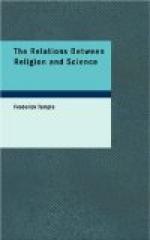This then is the answer to the question, Why do we believe in the uniformity of Nature? We believe in it because we find it so. Millions on millions of observations concur in exhibiting this uniformity. And the longer our observation of Nature goes on, the greater do we find the extent of it. Things that once seemed irregular are now known to be regular. Things that seemed inexplicable on this hypothesis are now explained. Every day seems to add not merely to the instances but to the wide-ranging classes of phenomena that come under the rule. We had reason long ago to hold that the quantity of matter was invariable. We now have reason to think that the quantity of force acting on matter is invariable. And to this is to be added the evidence of scientific prediction, the range of which is perpetually increasing, and which would be obviously impossible if Nature were not uniform. And yet again to this is to be added that this uniformity does not consist in a vast number of separate and independent laws, but that these laws already form a system with one another, and that that system is daily becoming more complete. We believe in the uniformity of Nature because, as far as we can observe it, that is the character of Nature.
And I use the word character on purpose, because it indicates better than any other word that I could find at once the nature and limitation of our belief.
For, if the origin of this belief be what I have described, it is perfectly clear that, however vast may be the evidence to prove this uniformity, the conclusion can never go beyond the limits of this evidence, and generality can never be confounded with universality. The certainty that Nature is uniform is not at all, and never can be, a certainty of the same kind as the certainty that four times five are twenty.
We can assert that the general character of Nature is uniformity, but we cannot go beyond this. Every separate law of nature is established by induction from the facts, and so too is the general uniformity. Every separate law of Nature is a working hypothesis. So too is the uniformity of Nature a working hypothesis, and it never can be more. It is true that there is far more evidence for the uniformity of Nature as a whole than for any one law of Nature; because a law of Nature is established by the uniformity of sequences in those phenomena to which it applies; whereas every uniformity of sequence, of whatever kind, is an evidence of the general uniformity. The evidence for the uniformity of nature is the accumulated evidence for all the separate uniformities. But, however much greater the quantity of evidence, the kind ever remains the same. There is no means by which we can demonstrate this uniformity. We can only make it probable. We can say that in almost every case all the evidence is one way; but whenever there is evidence to the contrary we cannot refuse to examine it.




